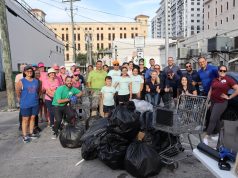The nation’s capital is a study in contrast.
While residents in Wards 2 and 3, a largely affluent area of Washington, D.C. which includes DuPont Circle and the Capitol Mall, enjoy a wide selection of accessible supermarkets and food establishments, those in the poorer neighborhoods of Wards 7 and 8 live in a food desert, which means a large portion of their population lives more than one mile away from the nearest grocery store.
DC Mayor Muriel Bowser’s 2022 budget allocates $58 million to eradicate food deserts in underserved parts of the city, and a new Lidl is planned to be constructed in Ward 7 by the end of the year.
“Our residents and families east of the river deserve an array of fresh and healthy food options and we will not stop until that goal is fulfilled,” said Bowser in a statement.
Only three of all 49 grocery stores in the nation’s capital are located in lower-income neighborhoods Wards 7 and 8, which encompass over 160,000 residents. Two of these stores are reportedly not easily accessible to many of the residents, and the stores’ price ranges fall outside of the affordability for local household incomes.
The median household income in the poorest neighborhood in Washington is $31,954, compared to the wealthiest area where it is $122,680.
On Wednesday, the United States Department of Agriculture announced a $2 billion plan–funded by the American Rescue Plan Act of 2021–to transform the U.S. food system and make it “fairer, more competitive [and] more resilient.”
About $155 million would go toward the Healthy Food Financing Initiative, which works to bridge the gap for those without accessible grocery store access in food deserts across the country.
“The pandemic and ensuing inflation caused by supply chain disruptions and Putin’s war against Ukraine underscores the difficulty of providing healthy and nutritious food for all when markets are disrupted,” Agriculture Secretary Tom Vilsack said Wednesday.
Graphic via Wikimedia Commons.
Ward 7 councilmember Vincent Gray wrote a letter to Bowser in 2021 detailing the intense need for food access in the lowest-income areas of DC.
“The lack of food options on the East End has been especially felt during this pandemic,” wrote Gray. “We know that equitable access to healthy food and full-service grocery stores is lacking on the East End which has a considerable deleterious impact on long term health. It is nearly impossible to have a healthy population with only three full-service grocery stores in Wards 7 and 8 to service 160,000 residents.”
Food deserts are not unique to the nation’s capital but have been particularly highlighted by the pandemic and even a recent shooting. They exist in areas with at least a 20 percent poverty rate and higher amounts of minority residents, according to the USDA.
South Florida is largely affected by a lack of food access as well, and the Miami-Fort Lauderdale area has the highest number of people living in a food desert in the state, as reported by NBC 6. South Florida is home to a total of 326 food deserts, according to the Sun-Sentinel.
The USDA found that 6.2 percent of the nation’s total population lives in a food desert, where access to groceries is an everyday struggle. This presents a significant health problem, as fast food is more accessible than healthy grocery options in these areas.
Residents of food deserts may be at a higher risk of health complications, adding to the struggles that many living in poverty already face.
Graphic via the Food at Home report by Enterprise Community Partners.
The Tops grocery store shooting in Buffalo that killed 10 left the location a crime scene, which closed the only easy-access grocery store in the vicinity – a place that residents advocated for years to get. Community activists say this serves as a reminder of the scope and reality of food inaccessibility.
“The consequences of not having this store open is going to be greater than we can all imagine,” Buffalo activist QueeNia AsheeMa’at told The Washington Post.
































